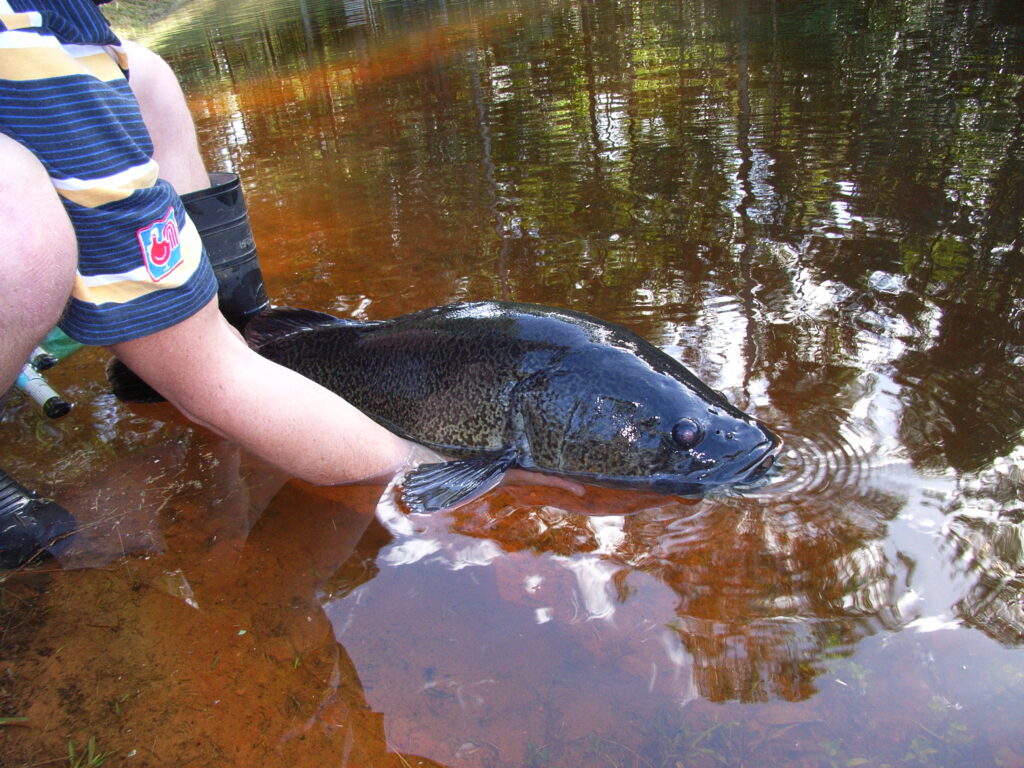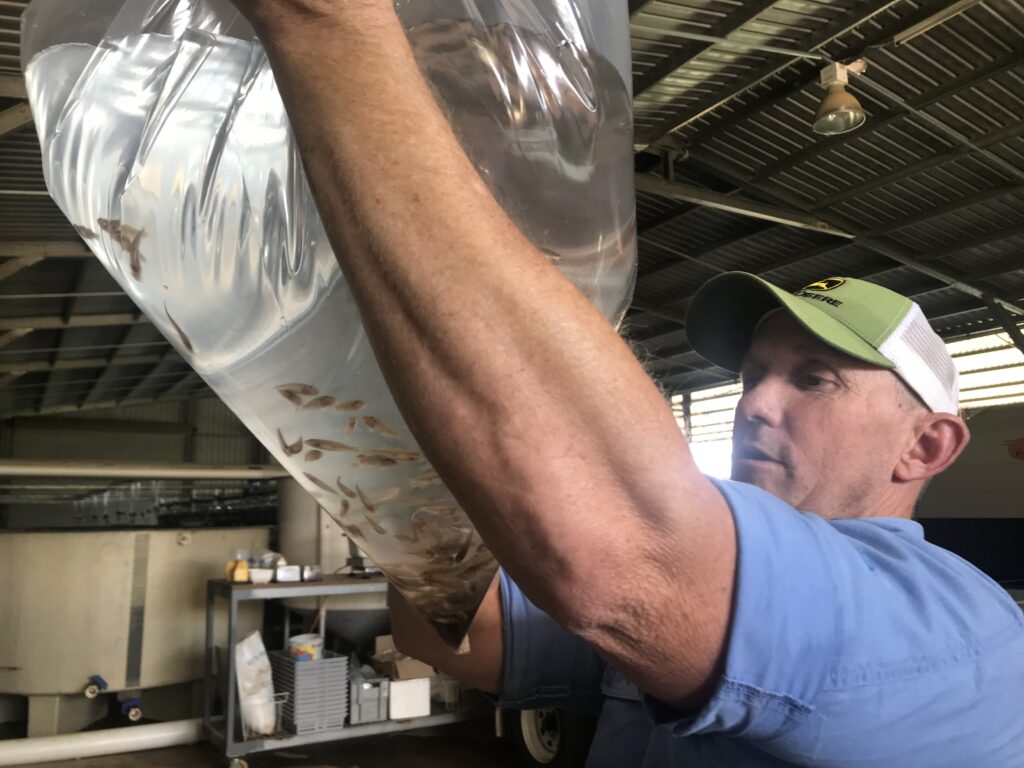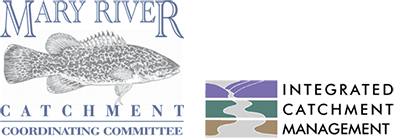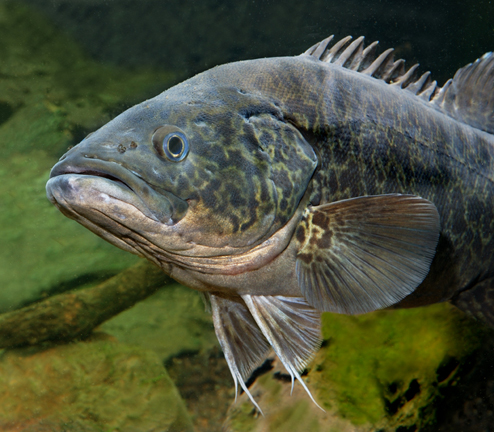Mary River cod
Mary River cod facts
Scientific Name: Maccullochella mariensis
Common Name: Mary River cod
Status: EPBC Act (1999): Endangered Distribution: Mary River and tributaries.
Habitat: Slow flowing freshwater streams in lowland areas and rocky upland streams. Favours deep pools, overhanging vegetation, boulders, logs and undercut banks.
Description: Large, elongated fish, slightly concave head profile with protruding lower jaw. Golden- yellow to green or dark brown with black to dark green mottling. Has been recorded at 23.5kg but usually less than 10kg.
Habits: Ambush predator. Lays eggs on underwater wood surfaces, preferably hollow logs.
Comments: endangered fish. Declines in population due to loss of riparian vegetation, de-snagging of waterways and overfishing.
The Mary River cod (Maccullochella mariensis) is an iconic species with a restricted distribution which is highly sought after as a recreational target species. Cod are listed as endangered under the EPBC Act largely due to habitat degradation and threats from overfishing.
The Mary River cod breeding program is a key recovery action for the species. The breeding program facilitates the restocking of genetically diverse fingerlings across their natural distribution in the Mary River catchment, and the creation of recreational fisheries in specific impoundmens in south east Queensland waterways, to take pressure off natural Mary River stocks, which are a no-take species in the Mary River catchment.
Download a copy of the Mary River cod brochure here.
Access the Mary River cod “Respected and Protected” video by clicking on this link.
Saving an endangered species from becoming extinct is a major exercise which takes years of commitment, planning and dedication from a wide range of organisations and individuals. It was almost 50 years ago when Gerry Cook recognised that Mary River cod numbers and cod habitat were rapidly declining, and a captive breeding program for the species was pioneered. With much trial and error and the ongoing dedication of many volunteers, at last count, over 800,000 Mary River cod fingerlings have been released since the breeding program began.
Mary River cod were listed as endangered by the Commonwealth Government in 1992 and in the early 1990’s, when the MRCCC first formed, the Mary River cod was adopted as the group’s signature species. Since then, much of the focus of the MRCCC’s work is aimed at improving cod habitat and ensuring the survival of the species. Also in the early 1990’s, the Mary River cod Recovery Team was formed with representatives from government and community, and the draft Mary River cod Recovery Plan was produced, which estimated that as few as 600 cod remained in the wild. Around this time the Mary River cod Community Network also formed, establishing the CodLine newsletter to spread the word about the plight of the cod.
Over 25+ years later, land managers throughout the catchment have embraced the need to protect and conserve cod habitat and improve water quality, not just for threatened aquatic species but also to improve productivity and reduce sediment and erosion. 
Despite all the work that’s been done, threats to the cod’s survival remain, including loss of habitat and illegal fishing. The Queensland Government recently passed new legislation aimed at protecting Mary River cod, particularly during the breeding season from August to October.
Mary River cod spawning is triggered by rising water temperature and usually occurs during August/September. The male Mary River cod guards the eggs after spawning, and is very protective of the nest. If a male cod is caught and removed or distracted by a passing lure, even for a short time, the entire season’s offspring are likely to die or be eaten.
This is where the fate of the species lies squarely in the hands of anglers.
For years the cod has been classified as a no take species and it’s illegal for an angler to “target” them in the Mary River Catchment. No angler ever admits to specifically fishing for cod but many accounts and footage on social media suggest otherwise. For a number of years there has been a “closed season” to protect cod in the breeding season, which many anglers seem to be unaware of.
The new fisheries legislation designates that the Mary River and tributaries upstream from the junction of Six Mile Creek and the Mary River, including Six Mile Creek will be closed to all line fishing (or possession of a fishing line) from the 1st August to the 31st October to protect Mary River cod during spawning. This does not include Baroon Pocket Dam, Borumba Dam and Lake Macdonald. In addition, Tinana Creek and its tributaries upstream of Teddington Weir will be closed to all forms of fishing all year round.
To offset the closures, Fisheries are expanding the list of impoundments that stock Mary River cod for recreational fishing to include Wyaralong Dam, Ewen Maddock Dam, Caboolture River Weir, Robina Lakes, Lake Kurwongbah, Enoggera Reservoir and Lake Manchester. This allows the recreational take of 1 Mary River cod minimum size 60 cm all year round in the stocked impoundments.
The Gerry Cook Hatchery at Mary River Cod Park on Lake Macdonald was temporarily closed in 2018, when Seqwater advised that the Lake Macdonald dam wall was in need of repair, and as a result, a new location would be needed for the breeding program to continue. This would involve establishing breeding ponds and winter housing for the 8 pairs of Mary River cod that were at the Hatchery, including breeding legend Geraldine, who had consistently produced thousands of eggs and fingerlings over years spent in the breeding program.
With financial support from Seqwater, a decision was made to relocate the breeding program to Hatchery Manager Darren Knowles’ rural property, a short distance from the hatchery as the crow flies, but a lengthy trip by road through the Cooroy hinterland.
Relocate the Hatchery. Relocate a breeding program for an endangered species.
Two small sentences, but a massive undertaking which needed a great deal of planning, hard work and expertise from Darren primarily, with the help of an army of volunteers and contractors.
Darren’s initial challenge was getting approval from the local council to establish an aquaculture facility on land zoned for strategic cropping. The entire process took around six years but was finalised in time to enable the infrastructure needed for the breeding program to be established at an alternate location.
Ponds for broodstock were established on Darren’s property with the required plumbing and electrical infrastructure needed to ensure the water quality was suitable, and the pipes installed which would replicate wild cod breeding habitat in each pond. Darren also established ponds for breeding plankton for the tiny cod fry. Winter tanks for the broodstock were transported to Darren’s enormous shed, and the necessary fittings installed to supply water and power to the tanks. Darren also undertook to breed blood worms for the fingerlings to minimise the cost of obtaining this food source from commercial operators.
The broodstock were transported from the Gerry Cook hatchery to Darren’s mid 2019, in preparation for their first breeding season in the new ponds. Unfortunately, although perhaps not surprisingly, no spawning occurred that first year, whether as a result of the very dry year or the late handling of the fish. Add to this the conditions needed for cod to spawn and the challenges are clear; the air and water temperature needs to be right, (in particular the temperature rise at the end of Winter), the fish have to be well fed and the pairs relatively well matched to reduce the likelihood of territorial behaviour, and the water quality needs to be near perfect. It’s also a reminder that finding suitable broodstock for the breeding program is not so simple when you are looking for an endangered species, and not all fish are suited to the hatchery environment.
Then there’s the challenge of collecting the closely guarded eggs from the breeding pipes without losing a finger or toe to the very protective and territorial cod father. Once the eggs are relocated to the troughs, the environmental conditions need to be just right to heat the water for the eggs to hatch, water that needs to be made pathogen free through a process incorporating ultraviolet light and ozone.
Regardless of all the preparation and precautions, an unseasonable cold snap can derail the entire breeding process, from spawning to the eggs hatching.
It’s therefore heartening to hear that Darren has been able to produce a number of successful spawnings since the closure of the Gerry Cook Hatchery, producing many thousands of fingerlings which have been released into the areas where there is suitable cod habitat in the Mary River catchment for conservation stocking, and many thousands more into impoundments in SEQ for recreational fish stocking.
For more information, please call the MRCCCC on 07 5482 4766, email admin@mrccc.org.au
or to enquire about cod fingerlings, contact Darren at the Hinternoosa Hatchery on 0407 126 256.


